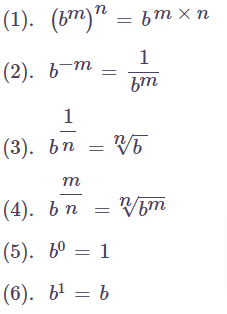In mathematics, Exponents and Indices are tools to rewrite long multiplication sums easily. This topic is covered mainly in algebra concepts. Algebra is one of the important branches in math subject that deals basically with the number theory concept.
Also, it is mainly referred to as the study of mathematical symbols. Superscript is determined as the one that is located above to the right of a number. This is called the exponent and the whole expression is known as exponentiation. Let us understand the formal notation of writing a number with an index at first followed by the laws governing it. So let’s begin!
What is the definition of Exponents and Indices?
Exponentiation is defined as the mathematical operation of raising a quantity to the power of another quantity. Exponential notation, Base, and Power are the three main primary concepts to learn the exponents. Exponents are often identified as powers or indices.
The definition of Index (Power) is the number that says how many times to use the number in a multiplication. The plural of an index is indices. In maths, Index or Power is formulated as “raising a number to the power of any other number”.
Notation of Exponents (or Index Numbers)

In case, we have written a number in the following form –
x = ay
Then the number x is said to be equal to the number a raised to the power y. a is called the base and y is called the power or index or exponent of a. Also, it can be evenly taken as –
ay = a x a x a x …..(y times)
where y can be any real number, a can be any real number for y ∈ Ζ (Integer) and is limited to being a positive real number for fractional values of y.
 Exponent Rules | Properties of Exponents & Indices | Laws of Exponents and Indices
Exponent Rules | Properties of Exponents & Indices | Laws of Exponents and Indices
Here, you will learn about the three major types of exponential properties to study the indices (or exponents) mathematically.
1. Product Rules of Exponents & Indices:
In maths, two types of product laws are involved and they are applied to multiply a quantity in exponential notation by another quantity in exponential notation.
- am x an = am+n
- am x bm = (a x b)m
2. Quotient Rules of Indices or Exponents:
In mathematics, you will find two types of division laws, and they are utilized to divide a number in exponential form by another number in exponential form.
- \(\frac { am}{ an } \) = am-n
- \(\frac { am}{ bn } \) = [(latex]\frac { b}{ c } [/latex])m
3. Power Rules:
You will get to know that there are six types of power rules that aid students to find the value of a variable or number with exponent.

Below is the sharable image on the laws of exponents/indices that helps kids to share with other friends and make them familiar with all properties of indices and exponents.

Exponents of Exponents
An index raised to an exponential number is known as Exponents of Exponents. For instance, let’s solve 324
In order to solve this expression, first, we calculate the exponent at the top and proceed with the next one;
Start with: 324 = 24
24 = 2x2x2x2 = 16
316 = 3x3x3x3x3x3x3x3x3x3x3x3x3x3x3x3 = 43046721
Hence, 324 is 43046721.
Solved Examples on Indices and Exponents | Laws of Exponents/Indices Questions and Answers
Example 1:
Find the value of the 253
Solution:
Given that 253
To calculate the value of the given expression, we have to multiply the base equals to 25 and how many times to do would be stated by the exponent of the number ie., 3
253 = 25 x 25 x 25 = 15625
Example 2:
Simplify the expression x = ya-b x yb-c x yc-a x y-a-b
Solution:
Given that x = ya-b x yb-c x yc-a x y-a-b
By using the first law of exponent/indices, we can simplify this expression;
x = ya-b x yb-c x yc-a x y-a-b
⇒ x = y(a–b)+(b–c)+(c–a)+(−a–b)
⇒ x = y−a−b
⇒ x = 1/ya+b, this is the final simplified expression.
Example 3:
If 2160 = 2a x 3b x 5c, find a, b and c. Hence calculate the value of 5a x 3-b x 2-c.
Solution:
Given that 2160 = 2a x 3b x 5c
2x2x2x2x3x3x3x5 = 2a x 3b x 5c
24 x 33 x 51 = 2a x 3b x 5c
2a x 3b x 5c = 24 x 33 x 51
Now, let’s compare powers of 2, 3 and 5 on both sides of an equation, we have a=4, b=3, c=1
Hence, find the value of 5a x 3-b x 2-c = 54 x 3-3 x 2-1
= 5x5x5x5 . 1/3x3x3 . 1/2
= 625 x 1/27 x 1/2
= 625/54.
FAQs on Rules/Laws of Indices with Examples
1. What are the three major rules of exponents?
The list of three major exponent rules in an algebraic form in mathematics are as follows;
- Product rules
- Quotient rules
- Power rules
2. Are indices and exponents the same?
In mathematics, index or power or exponents are the same. It is a number that raises to a variable or number. It indicated how many times a number has been multiplied by itself.
3. What is the most essential way of using indices and exponents?
The most important approach of using exponents and indices is to write large or small numbers. Scientific notations rely on power or exponents or indices to write such numbers in an easy manner.
